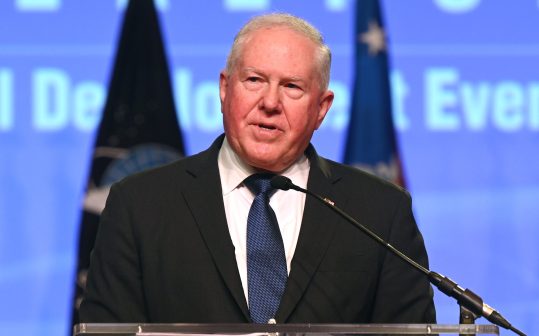The Air Force wants new authorities to kick off programs. Will Congress grant them?

The Department of the Air Force is requesting new authorities from Congress that would allow the services to begin development work on brand new programs before funding is appropriated, with the aim of speeding up military modernization. However, acquisition experts say that lawmakers may be hesitant to grant such powers to the Pentagon for a variety of reasons.
The Defense Department submitted a “Rapid Response to Emergent Technology Advancement or Threats” proposal to Congress on April 12 that would give the services the ability to begin development of new-start programs up to their preliminary design review level of maturity. The authority is intended to help circumvent delays that often occur during the traditional two-year budget cycles.
The request was announced April 19 by Secretary of the Air Force Frank Kendall, who told reporters during a media roundtable at the Space Symposium in Colorado Springs that waiting on Congress to pass a budget each year has delayed kick-starting a number of key programs for the Air and Space Forces.
The proposal would allow the Air Force and other services to get around issues that occur when Congress fails to pass appropriations bills on time, said Bill Greenwalt, a former senior staffer on the Senate Armed Services Committee and a former deputy undersecretary of defense for industrial policy.
When this happens, the Defense Department and other federal agencies must operate under continuing resolutions (CR) once the next fiscal year begins Oct. 1. Under a CR, the Pentagon generally cannot begin development of new-start programs that have likely already gone through a lengthy planning, programming, budgeting and execution process.
“What he’s basically saying is, ‘I’ve gone through all this time, I don’t want the Congress to stop me for six months on a CR — or what could be even worse, a full-year CR,’” Greenwalt, who is now a nonresident senior fellow at the American Enterprise Institute think tank, told DefenseScoop.
The authority would allocate money from coffers first created by Congress in 2003 to quickly buy and deploy capabilities needed during the post-9/11 wars, Greenwalt explained. The section has been amended since, and the current fiscal 2023 National Defense Authorization Act states that it is reserved for “urgent acquisition and deployment of capabilities needed in response to urgent operational needs for vital national security interests.”
According to the proposal being pushed by Kendall, R&D initiatives initiated under the newly sought authority would not exceed more than $300 million each fiscal year, and efforts that begin under the new authority would transition to an acquisition pathway after preliminary design review.
“What they’re allowing the department to do is to move money around without requiring congressional approval,” Mark Cancian, senior advisor at the Center for Strategic and International Studies (CSIS), told DefenseScoop.
The Department of the Air Force is requesting $55.4 billion in fiscal 2024 for research, development, test and evaluation efforts, including the creation of 12 new-start programs. The time it takes to stand up these programs can be lengthy and poses a risk for the Air Force as it addresses threats from adversaries, said Cynthia Cook, senior fellow and director of the defense-industrial initiatives group at CSIS.
“This length of time is not a weakness in the system per se — it represents the opportunity for the elected representatives of the United States to review programs and how taxpayer dollars are being spent,” Cook said in an email to DefenseScoop. “However, the threat does not stand still during the necessary bureaucratic funding processes, and by the time services get the funds, their needs may actually change. A two-year delay is a long time.”
Cancian said that Kendall makes a strong argument that the authority could speed up the budgeting process, but that he and the Pentagon will still likely face apprehension from lawmakers.
“The pushback from Congress is going to be concerned that DOD will start a program that will then build momentum so that it cannot be stopped,” he said. “One of the great concerns about programs is that DOD gets them started before really appreciating what the long-term cost is going to be before doing an analysis of alternatives. And then the program gathers momentum, and even if it turns out to not be a promising approach, you’re sort of committed.”
The $300 million cap does limit how much the services could invest in these types of efforts in a fiscal year, mitigating the sudden creation of multi-billion-dollar programs, Cancian noted. Still, there is a risk that down the line the authority could be abused, he added.
“With new authorities, the Air Force could move more quickly to counter the threat,” Cook said. “The question is whether the Air Force would be able to offer sufficient communication and transparency to Congress about how they perceive the threat and the nature of their decision-making to rapidly counter the threat, to satisfy Congress in its oversight role.”
At the same time, Greenwalt said that the Air Force may be able to begin the development with existing acquisition tricks that either circumvent CR-related delays or are better suited for the programs it’s concerned about.
In the event of a continuing resolution, the Defense Department can request so-called anomalies attached to the CR that act almost like “mini-appropriations” and grant the department funding for programs like new starts, Greenwalt explained.
The Pentagon could also use a Middle Tier of Acquisition authority to rapidly prototype and test within three to five years, he said. Given the capabilities the Department of the Air Force seems most concerned about being delayed, Greenwalt said this existing authority would be more appropriate to quickly develop these programs.
“They asked for programs that need to mature to [preliminary design review]. Significant data point in the requirement there, because what it states is the department is thinking about traditional defense acquisition … because PDR is a gate that you use to go into engineering and manufacturing and development in that larger 15- to 20-year timeframe,” he said. “If that’s what they’re looking for, six months worrying about the appropriators isn’t going to matter.”
Greenwalt described the proposed authority as “using a sledgehammer to kill a mosquito,” and said that while some lawmakers will initially consider it, Congress will most likely reject the proposal in the end.
“Believe me, the appropriations committees and staff deserve to be raked over the coals for not supporting speed and agility in acquisition,” he said. “But this provision is not the way to engender the type of reaction that’s necessary.”
DefenseScoop has reached out to the House Armed Services Committee and the Senate Armed Services Committee for comment on the DOD proposal. This story will be updated when responses are received.
Kendall, Air Force Chief of Staff Gen. Charles “CQ” Brown and Chief of Space Operations Gen. Chance Saltzman are scheduled to testify before the HASC on Thursday, where they may face lawmakers’ questions about the proposal.






